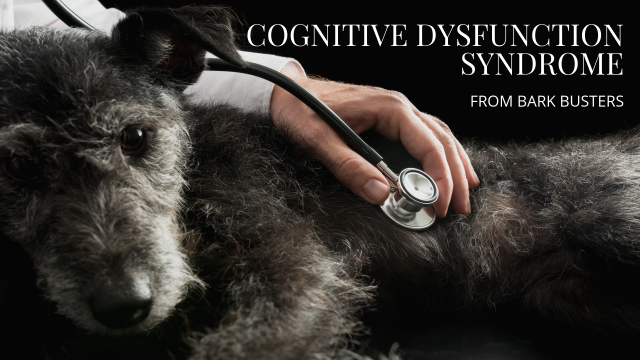Our dogs bring such joy in to our lives! For many, it may be emotionally difficult to deal with an aging pet and to cope with the reality that a dog isn't the same youthful puppy we brought home all those years ago. As dog owners this is an unfortunate reality most of us will inevitably face, as we often out-live our pets.
Dogs are susceptible to physical and cognitive degeneration in the same way as humans, and since there is no way to stop it, it’s important to become familiar with the signs of Cognitive Dysfunction Syndrome (CDS). By educating yourself on the symptoms of CDS and knowing what to look for, you can identify it early on and consult with your vet for information and tips from Bark Busters on how to help your dog in his/her late stage of life.
While we cannot stop the brain from aging, there are activities you can engage in with your dog that will keep their brain alert and active, and subsequently slow down the degeneration of the brain’s nerve process. These include:
- Regular play sessions and varied interactive games
- Regular exercise
- Simple challenges such as ‘hide and seek' or 'find the treat' and brain stimulating toys or puzzles, like the Game Changer from Bark Busters!
- Feeding a well-balanced diet rich in essential nutrients
Despite our best efforts, research has shown that 50% of dogs over 11 years will show signs of CDS with that number increasing to nearly 70% of dogs over 15 years.
Signs and Symptoms:
Is your dog showing signs of age and a general decline in brain function? What should you be looking for? Some signs and symptoms include:
- Slower to respond
- Blank look in the eyes and maybe doesn’t recognize your voice or his name
- Continuously circling
- Getting lost in the house, or repeatedly getting stuck in a certain place
- Toileting in the house where previously house-trained
- Making noises that are inappropriate or out of character, such as: whining, panting or barking for no apparent reason
- Changes in sleeping patterns
- Anxiety, restlessness, or irritability that is out of character
- Inability to follow familiar routes
- Lack of self-grooming
- Loss of appetite
If you begin to notice some of these symptoms, start keeping notes for your vet that you can share at an upcoming appointment. By being able to provide your vet with more specific details of your dog’s condition and concerning habits, your doctor will be better informed and better able to help you both.
The symptoms of CDS are similar to other conditions of old age, so your vet may run additional blood and urine tests, and possibly conduct an ultrasound and/or x-ray. Combining the results from these tests and the notes you’ve shared about your dog’s recent behavior, your vet will be able to make an informed diagnosis.
Once your dog has been diagnosed with CDS, he/she will need life-long support and monitoring. By providing consistent routines and a healthy living environment, you can help make your pup more comfortable in your home. While regular stimulation will be helpful, it’s important that it does not produce any anxiety for them. Changes to your dog’s diet may also be recommended by your vet to include foods with specific nutrients or dietary supplements that can be helpful to improving cognitive function.
Continue to keep a record of your dog’s symptoms so you will be able to notice a change in their condition and alert your vet that things are staying the same or worsening. Regular vet visits are important to monitor and evaluate your dog’s health and make changes as needed.
Next Steps:
It's natural to feel lost and helpless after diagnosis as you only want the best for your furry friend. But there is so much you can do to make their life happy and comfortable during this time of change!
By establishing security and routines in your home, your dog will feel safe.
Some steps you can take include:
- Keep your dog’s food and water bowls and any other essential items in the same place and where your dog can access them easily
- When leaving your dog alone, limit access. Consider keeping your pup in a smaller space such as the kitchen or utility room. This space restriction will prevent him/her from becoming lost in the house and will allow time and space to rest peacefully
- Be conscientious about your routine so that you reduce any potential for confusion
- Be ready to take your dog outside more regularly to prevent accidents inside the home. Never scold your dog for accidents inside the house, simply clear them up. Accidents from a dog who has previously been house-trained in the past may make your pup anxious - don’t add to their distress
- Ensure that exercise is regular even though this will be limited to the extent of your dog’s physical capabilities
- Remember that short training exercies and brain stimulation is as important as physical exercise and can help prolong additional symptoms.
This will be a time of change for the whole household. It can be stressful at times, but by facing reality head on and recognizing that your dog is showing the signs of dementia, you can respond appropriately. Show your pet patience and compassion for their cognitive degeneration as it will only allow them to continue to feel safe and loved in their home. While it may feel different, find joy in the time you have together and love them with all your heart!
